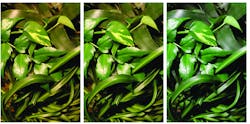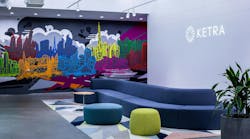Have you ever noticed that indoor ornamental plants don’t last very long? Biophilic design trends have flooded interior spaces with greenery due to the positive impact that vegetation has been shown to have on people’s well-being and productivity, but the plants’ short life spans make it expensive to keep bringing in the green. Could LED lighting make a difference?
The folks at the Zurich-based lighting design firm lightsphere teamed up with a Gdansk University of Technology professor to test out the biological effects of LED-specific wavelengths in a research paper, “LED Light Sources and Their Complex Set-Up for Visually and Biologically Effective Illumination for Ornamental Indoor Plants.”
“This new research addresses a necessity in lighting design practice, in which there are no regulations and guidelines so far to help lighting designers, architects, and landscape architects understand how plants can thrive indoors with LED light,” explains co-author Julia Hartmann, IALD, CLD, lightsphere principal and founder. In addition, co-author Dr. Karolina M. Zielinska-Dabkowska, IALD, IES, CIE, MSLL, assistant professor, Gdansk Faculty of Architecture and co-founder of the GUT LightLab in Poland, laments the disconnect between academia/research, lighting practice and the lighting industry. “With very little research and no established standards regarding this important topic, it is often left to individual lighting design practices to do their own research for individual projects,” she explains. So, when Hartmann and lightsphere colleague Carla Sigillo approached her with the idea of a study to help determine the optimal action spectrum of LEDs for the visually and biologically effective illumination for plants and humans, she joined as a full partner in the research.
Lightsphere became interested in the subject in 2016 when asked to develop a lighting solution to optimize indoor plant growth for the Zurich Innovation Center Givaudan project. It was then that the designers discovered almost no useful information on the lighting spectrum and its impact on plant growth. “Within the project planning for Givaudan, we decided to undertake our own study of different full-spectrum LEDs used in architecture,” relates Hartmann. “The first findings showed that the spectral composition of the lighting plays a decisive role in how plants develop.” To further this initial research, they embarked upon this study, ultimately published in MDPI’s Sustainability journal.
The Research
Because LED lighting levels for simulating the sun’s natural plant-inducing growth properties are not the same as people’s circadian-based, glare-free needs, this has often torpedoed traditional attempts to grow healthy indoor gardens.
Focusing on four variables—the light spectrum, light energy intensity, timing, and duration of light—the study analyzed a variety of dynamic circadian light patterns. They recorded key light properties, including correlated color temperature (CCT), color rendering index (CRI), spectral power distribution (SPD), peak light wavelength, photosynthetic photon flux density (PPFD), and daily light integrals (DLI).
The researchers were then able to determine which SPD curve—combined with duration and dimming—yielded the healthiest plants by providing the most appealing and natural look. This is essential because when ornamental plants are part of a design, their natural appearance is vital for humans to interact on a biological and psychological level.
Industry Response
Judging from the fact that the paper has been viewed and downloaded more than 6,000 times, the researchers really hit a chord. “We are now seeing manufacturers publishing articles referencing our research and lighting designers writing blogs and articles that reference our publication,” reports Hartmann. “Furthermore, I was invited to talk about the topic at the international IALD Enlighten conference.” For example, lighting manufacturer Xicato performed a study, “Optimum Lighting of Plant Walls,” and Erco produced a “Green Wall Lighting” white paper.
“Our study definitely started a ball rolling and a push for manufacturers and designers to realize the complexity of the issue,” confirms Hartmann. “However, more research and especially education is needed to advance optimal lighting and lighting solutions for ornamental plant lighting.”
This article appeared in the March 2022 issue of Architectural SSL magazine.






